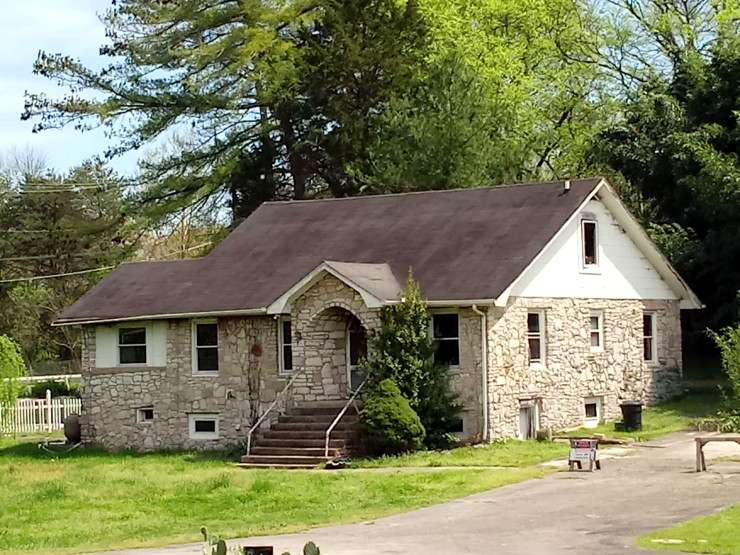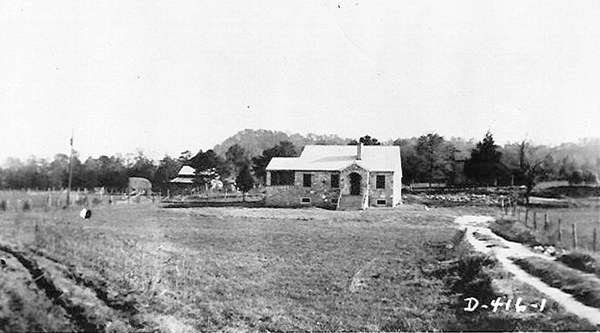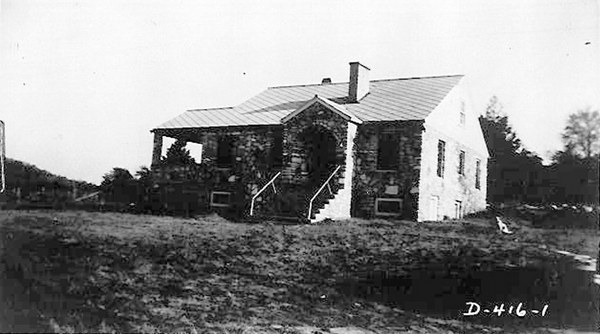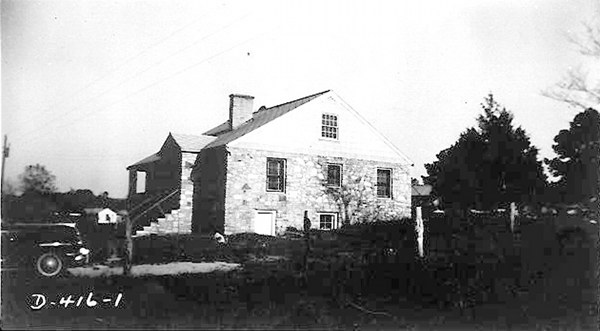
Note: This story was updated at 2:35 p.m.
A home in east Oak Ridge that was built before World War II is for sale. It’s one of the few structures that was built before the war and remains in the city today.
The Luther Brannon House is at 151 Oak Ridge Turnpike, just west of Melton Lake Drive and next to the U.S. Department of Energy’s Office of Scientific and Technical Information. It’s listed on the National Register of Historic Places, and it was the first home in Oak Ridge to be privately owned.
The single-story stone bungalow was built by Owen Hackworth in 1941 and soon acquired by the federal government as part of the top-secret Manhattan Project during World War II. Hackworth was a longtime resident of the Clinch River Valley.
Don Raby provided Oak Ridge Today with early photographs of the home after a fire damaged the house in 2014. It’s not clear how extensive the damage was or if repairs have been made.
Raby has collected photographs of the original structures that were here before the Manhattan Project, when the “secret city” that is now Oak Ridge helped build the world’s first atomic bombs. The 59,000-acre military reservation, which replaced several rural communities, was known first as Kingston Demolition Range and then as Clinton Engineer Works.

The Luther Brannon House was acquired by the federal government in 1942, according to the home’s registration form for the National Park Service’s National Register of Historic Places. The home was one of the most modern structures in the valley when purchased by the federal government, according to a property documentation form filed with the National Register of Historic Places in 1991.
“Built near the community of Elza, the house is the only extant residence associated with the original valley settlements,” the form said.
As of 1991, there were only three pre-World War II dwellings left in Oak Ridge: the Luther Brannon House; the Freels Bend cabin, a 19th-century log structure located near the Clark Center Park in south Oak Ridge and the city’s oldest building; and the J.B. Jones House built around 1920 on Old Edgemoor Road across from the Bull Run Steam Plant.
There are also two churches that pre-date the construction of Oak Ridge: the George Jones Memorial Baptist Church in the former Wheat community in west Oak Ridge and the New Bethel Baptist Church on Bethel Valley Road near Oak Ridge National Laboratory.
The Luther Brannon House is the only pre-war house that remains inside the city proper. It is named after Luther Brannon, whose family lived in the house since 1946.
Luther Brannon came to Oak Ridge in September 1943 to manage the Chevrolet dealership on the town site, according to the National Historic Register registration. He worked for Chevrolet until 1950, when he went into business for himself. Danny Brannon, Luther Brannon’s grandson, said his grandfather, a businessman, was known as “Lefty.”
“Brannon was one of the private concessionaires who came to Oak Ridge (as) a part of the Army’s plan to provide a semblance of normalcy to townsite residents under extraordinary conditions that existed until the city was incorporated in 1959,” the registration form said.
Besides its wartime connections, the Luther Brannon House is also important in post-war history because it represents an important step in the city’s move toward independence from government control.
“In preparation for incorporation of the townsite, all houses in Oak Ridge were released for sale to the public in 1956,” the registration form said. “Brannon’s house was slated for demolition because of its location in a designated commercial area.”
The house is the only home in the middle of a commercial district on the south side of Oak Ridge Turnpike.
“Mrs. Brannon wrote to War Department officials in Washington, D.C., for permission to remain in her house,” the registration said. “The Brannons were granted special permission to purchase the house and were the very first homeowners in Oak Ridge.”
In 2001, The Oak Ridger newspaper reported that 180 of the pre-World War II houses were used to alleviate the severe housing shortage on the 59,000-acre military reservation in Oak Ridge during the war. The city’s population quickly swelled to 75,000 during the frenzied top-secret effort to build the world’s first atomic bombs—before Germany could—and homes, businesses, and military activities replaced acres of farmland and several rural communities. Almost all of the remaining pre-World War II homes were torn down after the war, The Oak Ridger said.



Leave a Reply